Barndoor Skate
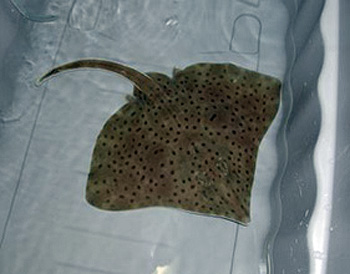
Dipturus laevis
These long-lived, slow-growing skates have diamond shaped pectoral discs with very pointed snouts and stout tails. They are reddish brown on top, with dark spots, dark blotches and light streaks; and they are light underneath with some light markings. These bottom-dwellers are the largest of North America’s Atlantic coast skates, growing to an average of around 30 inches long, but reported at almost 60 inches in some cases.
Order – Rajiformes
Family – Rajidae
Genus – Dipturus
Species – laevis
Common Names
The common name in the English language include barndoor skate, barn-door skate, and barn-door winter skate. Other language common names include deurrog (Dutch), grande raie (French), and ladeportsrokke (Danish).
Importance to Humans
The barndoor skate is one of five skates in the Gulf of Maine that has commercial value and is also considered a game fish. It is often captured in commercial trawling nets such as otter and scallop trawls. There is also a directed fishery for dogfish and skates on the Georges Bank which has resulted in the decline of this species. The flesh is used as bait, fish meal, pet food, and meat from its wings is sold for human consumption.
Danger to Humans
Barndoor skates are considered harmless to humans.
Conservation
Intensive trawling has threatened the barndoor skate with extinction, mainly through by-catch in multi-species fisheries. Also, shallow water populations have been severely over fished because skates have been targeted as a more valuable species to harvest. Fisheries independent studies by the National Marine Fisheries Service indicate a peak abundance in the early 1960s, declining to a low in the 1980s. From the mid 1960s to the 1990s, barndoor skates declined 96-99% with 400 miles of the center of its longitudinal range on the southern shelf. In the 1990s, fishing effort has declined in shallow areas of barndoor skate habitat and the number of juveniles is increasing in no-take zones on Georges Bank and Southern New England shelf as well as adjacent areas to the north and south. The barndoor skate is currently a prohibited species in US waters while the biomass is slowly recovering from its over fished condition.
> Check the status of the barndoor skate at the IUCN website.
Geographical Distribution
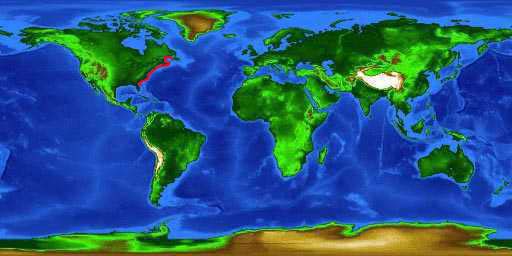
The barndoor skate is the largest skate residing in waters along the Atlantic coast of North America. Its northernmost border includes the banks of Newfoundland, the southern Gulf of St. Lawrence, and the outer coast of Nova Scotia. To the south, the barndoor skate inhabits areas as far as the northeast coast Florida (US). During the warmer summer and autumn months, the barndoor skate moves offshore, returning to inshore waters in the winter and spring.
Habitat
The barndoor skate can be found on various types of ocean bottom including soft muddy, sandy, and rocky bottoms. It can be found from shoreline to, though it is most abundant at depths less than 492 feet (150 m), depths of up to 2,460 feet (750 m). The broad temperature range in which the barndoor skate lives and breeds, from just above freezing to 68°F (20°C), can account for the depth distribution of the species. Though the barndoor skate has been found in brackish water where the salinity is 21 to 24 parts per thousand (ppt), it prefers salinity between 31 and 35 ppt.
Biology
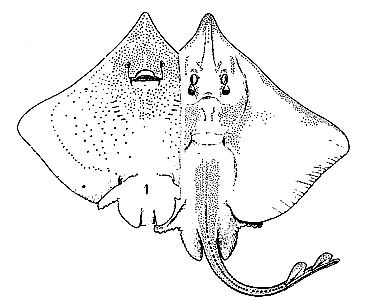
Distinctive Features
The broad disk of the barndoor skate has sharply angled corners and a pointed snout. The front edges of the skate’s disk are concave and its dorsal fins are close together. The posterior disk corners are rounded and the tail is moderately short. The barndoor skate can be distinguished from other skates by a straight line that begins at the snout and ends at the anterior margin of the outer corner of the disk, but does not intersect the disk.
Coloration
The upper surface of the barndoor skate is brown to reddish brown. This surface is marked with darker spots and blotches, along with lighter streaks and reticulations. In particular, the center of each pectoral fin is marked with an oval spot or blotch. The barndoor skate has a light, white to gray, lower surface. This surface is marked with gray blotches on the snout that are more numerous in larger individuals. Both surfaces contain darkly pigmented ampullar pores near the eyes, snout and on much of the anterior disk.
Dentition
The teeth of female and immature male barndoor skates are close-set and have rounded cusps. Teeth of mature males are widely spaced and arranged in rows, with sharp-pointed cusps. The upper jaw of this skate consists of 30- to 40-tooth rows and the rows of the lower jaw each contain between 28 and 38 teeth.
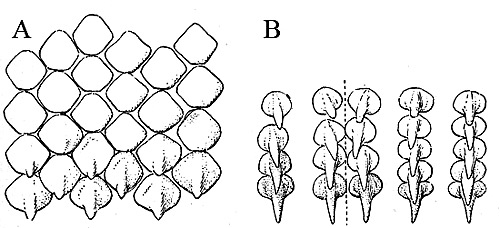
Denticles
Denticles are absent from small specimens of the barndoor skate. Larger specimens have relatively small thorns on anterior and posterior orbital rims and along the midline and in a line along the lateral aspect of the tail and between the dorsal fins. Mature females also possess dermal denticles on the head and shoulders, and along the dorsal midbelt of the disk and tail. The thorns are absent from the dorsal midline of the disk and from the shoulder region of the skate to the base of the tail.
Size, Age, and Growth
The barndoor skate is one of the largest skates in the north Atlantic Ocean. It is long-lived and slow growing. Reportedly, one captured specimen measured nearly 59 inches (150 cm) TL and weighed almost 40 pounds (18.0 kg). There have been unconfirmed reports of specimens that have reached 71 inches (180 cm) TL. Studies show that a barndoor skate weighing 4-7 pounds (2-3 kg) averages a length of 28-30 inches (71-76 cm).
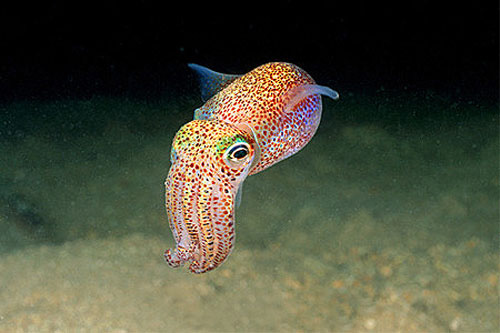
Food Habits
The prey of the barndoor skate consists mainly of fishes and invertebrates associated with the bottom. Such food items include polychaetes, gastropods, bivalve mollusks, squids, crustaceans and fishes. Small individuals subsist on benthic invertebrates such as polychaetes, copepods, amphipods, isopods, crangon shrimp, and euphausiids. Larger specimens are capable of capturing larger and more active prey, including razor clams, large gastropods, squids, cancer crabs, spider crabs, lobsters and fishes. Garman noticed that many times, the thorns on the snout of barndoor skates are worn smooth, as though the snout is used to dig in the mud or sand to obtain bivalve mollusks.
Reproduction
The barndoor skate is oviparous, meaning it lays eggs from which the young hatch. The skate becomes sexually mature at 11 years of age and reproduction takes place over the entire range of the species. During mating it is known that a distinct pairing with embrace occurs; though this activity has not been studied extensively in this species. The barndoor skate deposits single fertilized eggs in the yellowish and greenish egg capsules in sandy or muddy flats. Incubation takes approximately 6 to 12 months. The smooth egg capsules of the skate are rectangular, with a short horn at each corner and fine filaments along the anterior and posterior margins. Though small specimens are rarely captured, hatchlings have been measured at (180-190 mm) TL. It has also been noted that young barndoor skates tend to follow large objects such as their mother
Predators
Due to the large size of the barndoor skate, large sharks are its only likely predator of adult barndoor skates.
Parasites
The numerous parasites of this skate include turbellarians, trematodes, cestodes, nematodes and copepods.
Taxonomy
The barndoor skate was described in 1818 by Mitchill with the original combination of Raja laevis. The scientific name was later changed to the currently valid name Dipturus laevis. The genus name, Dipturus, is derived from the Greek words, di, meaning two, and pteryx, meaning fin. Raja, the original genus of Dipturus laevis, which was coined by Linnaeus in 1758, is still recognized as a valid subgenus.
Prepared by: Mary Jane Wettstein